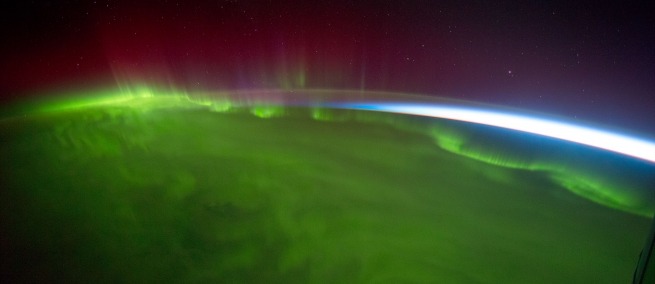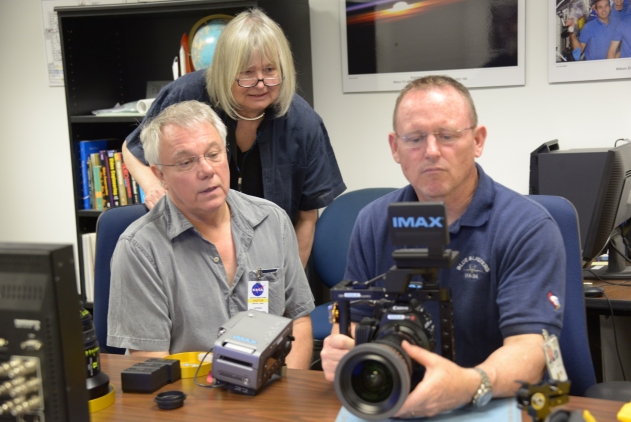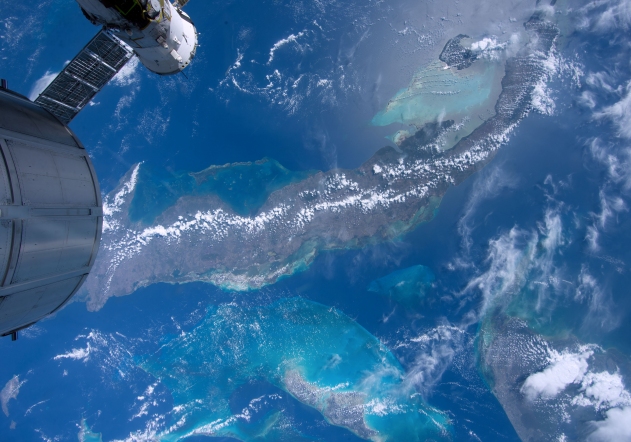
NASA astronauts–including Commander Scott Kelly the first one-year crewmember–went through a crash course in film school before ascending 250 miles above the earth to the International Space Station to shoot A BEAUTIFUL PLANET. IMAX films are known for bringing audiences to never before seen places; in A BEAUTIFUL PLANET New Zealand and Mt. Everest are seen for the first time from space. Watching the film is a truly visceral experience; it is only 40 minutes but it is transporting. This is IMAX’s first film shot on digital footage so it was possible to shoot more than one take—the filmmakers ended up with over 11 terabytes of data, more than 250,000 frames, which gave them unprecedented flexibility in editing.
Toni Myers is director, writer, producer, and editor of A BEAUTIFUL PLANET. She has an extensive history making space films such as HUBBLE 3D and BLUE PLANET. Going back to 1984, Myers has trained about 160 astronauts. BLUE PLANET showed one of the first images of the thin blue line which separates earth from the vast blackness of space.
Narrated by Academy Award-winning actress Jennifer Lawrence, A BEAUTIFUL PLANET focuses on climate change: Greenland ice sheets melting and deforestation across Madagascar. It comes at a crucial time; this March was the warmest on record.
Science & Film spoke in person with astronaut Commander Barry E. “Butch” Wilmore; Flight Engineer Dr. KJell N. Lindgren; retired astronaut and the film’s Space Operations Consultant Marsha Ivins; and the film’s director Toni Myers; as well as climate scientist and Director of the NASA Goddard Institute for Space Studies Dr. Gavin Schmidt, in New York. A BEAUTIFUL PLANET will open in theatres on April 29, to coincide with Earth Day.
Astronaut Butch Wilmore shot A BEAUTIFUL PLANET. “I think I’m the most fortunate astronaut in recent history because of this. […] I was involved with getting shots of various parts of the planet that had never been shot before, like New Zealand. [Toni Myers] had tried to get New Zealand for months, and it was always cloud covered. Then one day I looked at the map, we have a predictor, and it said no clouds over New Zealand and I thought, yeah right. But I saw it in the distance coming over the horizon and I said, I don’t think there are clouds. So I got my cameras set up and that was the only day in orbit there were no clouds over New Zealand. It’s exciting to be a part of this.”
For a film where the director was hundreds of miles from her crew, with modern technology they were able to be in touch. “I would call,” said Wilmore. “That’s really fun, getting a call from space,” said director Toni Myers. “It’s kind of like drunk dialing, because [the astronauts] love to ambush people. Everybody has the same reaction [when getting a call]: ‘What?! You’re calling from space?!’ When you really think of it, it’s only 250 miles in a different direction, but still. We could email back and forth, so that is one of the great boons of the present day because we could communicate and send a little PowerPoint up and say: if you’re shooting an interior sequence this would be great as a cut-away. So you could actually illustrate what you were looking for. In the early days, you wrote a flight note with four carbon copies that, by the time it got to the front room, it would be mangled and say the opposite of what you meant. Communications now are much better.” “I would send Toni just one picture of the many thousands I would take on a single run and I would say, I am writing my acceptance speech for the Oscar for best cinematographer just because it’s so spectacular,” said Butch. Myers replied, “and indeed it was. This was a shot that he did of the whole North American continent looking north and the Aurora is on the horizon in Canada and you can see all of the Great Lakes, this is at night. In the earlier films, with film, we couldn’t expose that. The film was too slow. With digital, with the dynamic ranges, we got stars and moonlight and all kinds of things. The Academy Award shot was every city in the US,” “An Aurora to the north and a sunrise coming and it meets the aurora, it’s just wow. And then I got a night shot of the Bahamas with the full moon and the water and said, okay I’m writing another speech!” said Butch.

“With a film camera, we had seven minutes of film on a shuttle mission and we took 30 second shots so we’d have 20 shots, maybe,” said the film’s consultant Marsha Ivins. “Everything you saw on an IMAX movie until this one was the first and only take. Ask Hollywood people about that, that’s not how it’s done. And, done by non-professionals. The crew is trained to be not only the actors, but the directors and the lighting people and the hardware and the sound guy. They bring in really good sound people and you learn to tell a story with sound the same way you tell a story with light. It’s not handicam point and shoot kind of stuff. That’s been consistent through all IMAX [productions]. What’s different with this movie is that using a digital camera you get the opportunity to take two, or take twenty shots, depending. So that’s what the crew did this time.” One of the main missions of the crew filming the earth is to share a perspective of the changing landscape, which can only be seen from above.
The effects of people on the planet are starkly visible from space. Flight Engineer and filmmaker Kjell Lindgren said, “while we were up there, there was a part of Asia […] [where] they had a clean air day. They limited the number of automobiles and those sorts of things, and within days we were able to see a city that we had not been able to see the entire time we were up there. It’s very clear we change the earth for good or ill.” “You can see an image and you know things are changing,” said climate scientist Gavin Schmidt. “These kind of movies [which capture the view of] a very, very privileged [person] flying out there get shared with other people through the work that [they’re] doing.”

“[Earth] is a unique and beautiful place, unlike any other that we know of right now. We spend an inordinate amount of time on the space station taking care of this vehicle that is taking care of us, that is our home for five months, six months, a year. And yet on earth, which is also a spaceship for all of us, it is our home, we spend nowhere near the same amount of time taking care of this larger spaceship,” said Lindgren. Many of the scenes in the film involve the crew going down the checklist of chores they have to complete to maintain the spacecraft—everything from vacuuming to putting away provisions. They are also trying to grow food; one day they uncover freshly grown lettuce in a scene reminiscent of the Sloan-winning film THE MARTIAN.
Are there any good Hollywood movies about space? Lindgren said, “I really enjoyed watching THE MARTIAN. Our crew got to see it in space, so that was doubly fun. […] The main character Mark Watney was going through the food list. We were sitting in our galley watching and said, that’s our food: beef stroganoff, shrimp cocktail. So I remember just little things like that kind of gave me goose bumps.” According to Lindgren, watching a movie in space is: “very very interesting. Scott Kelly actually noticed this. We have a projector and a big screen up there, so on Saturday nights we get everyone together, and he noticed that we would all strap ourselves down on the floor so we were sitting or laying back to watch a movie. In space, if you just float upright you’re completely relaxed; you could fall asleep in that position. But there is something uncomfortable about watching a movie standing straight up. So we would all strap ourselves down under bungees. There’s something about being in the reclined or sitting position that is more comfortable.”
A BEAUTIFUL PLANET is a documentary made in cooperation with NASA shot by astronauts aboard the International Space Station. See the film in exclusive IMAX and IMAX 3D engagements beginning April 29.
All images from IMAX Entertainment and director Toni Myers and narrated by Jennifer Lawrence, A Beautiful Planet is a stunning glimpse of Earth from space, bringing a heightened awareness of our planet—and the effects of humanity over time—as never seen before. Exclusive IMAX® 2D and 3D engagements begin April 29, 2016. © 2016 IMAX Corporation.